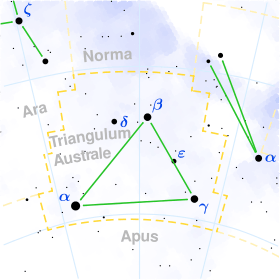Delta Trianguli Australis
Delta Trianguli Australis (δ TrA, δ Trianguli Australis) is a single,[7] yellow-hued star in the constellation Triangulum Australe. It is approximately 606 light years (182 parsecs) from Earth.
 | |
| Observation data Epoch J2000.0 Equinox J2000.0 | |
|---|---|
| Constellation | Coma Berenices |
| Right ascension | 16h 15m 26.26979s[1] |
| Declination | −63° 41′ 08.4492″[1] |
| Apparent magnitude (V) | 3.86[2] |
| Characteristics | |
| Spectral type | G5II[3] |
| B−V color index | +1.10[2] |
| Astrometry | |
| Radial velocity (Rv) | −4.90[4] km/s |
| Proper motion (μ) | RA: 2.73[1] mas/yr Dec.: −12.92[1] mas/yr |
| Parallax (π) | 5.37 ± 0.17[1] mas |
| Distance | 610 ± 20 ly (186 ± 6 pc) |
| Absolute magnitude (MV) | −3.9[5] |
| Details | |
| Luminosity (bolometric) | 1,209[6] L☉ |
| Surface gravity (log g) | 1.54[2] cgs |
| Temperature | 4,946[2] K |
| Metallicity [Fe/H] | −0.05[2] dex |
| Other designations | |
| Database references | |
| SIMBAD | data |
This is a G-type giant star with a stellar classification of G5II[3] and an apparent magnitude of +3.86.[2] It has a visual companion, a 12th magnitude star separated by 30 arcseconds.[8]
References
- Van Leeuwen, F. (2007). "Validation of the new Hipparcos reduction". Astronomy and Astrophysics. 474 (2): 653. arXiv:0708.1752. Bibcode:2007A&A...474..653V. doi:10.1051/0004-6361:20078357.
- Luck, R. Earle (2014). "Parameters and Abundances in Luminous Stars". The Astronomical Journal. 147 (6): 137. Bibcode:2014AJ....147..137L. doi:10.1088/0004-6256/147/6/137.
- Tetzlaff, N.; Neuhäuser, R.; Hohle, M. M. (2011). "A catalogue of young runaway Hipparcos stars within 3 kpc from the Sun". Monthly Notices of the Royal Astronomical Society. 410: 190. arXiv:1007.4883. Bibcode:2011MNRAS.410..190T. doi:10.1111/j.1365-2966.2010.17434.x.
- Gontcharov, G. A. (2006). "Pulkovo Compilation of Radial Velocities for 35 495 Hipparcos stars in a common system". Astronomy Letters. 32 (11): 759. arXiv:1606.08053. Bibcode:2006AstL...32..759G. doi:10.1134/S1063773706110065.
- Reimers, D.; Huensch, M.; Schmitt, J. H. M. M.; Toussaint, F. (1996). "Hybrid stars and the reality of "dividing lines" among G to K bright giants and supergiants". Astronomy and Astrophysics. 310: 813. Bibcode:1996A&A...310..813R.
- McDonald, I.; Zijlstra, A. A.; Boyer, M. L. (2012). "Fundamental parameters and infrared excesses of Hipparcos stars". Monthly Notices of the Royal Astronomical Society. 427: 343. arXiv:1208.2037. Bibcode:2012MNRAS.427..343M. doi:10.1111/j.1365-2966.2012.21873.x.
- Eggleton, P. P.; Tokovinin, A. A. (September 2008), "A catalogue of multiplicity among bright stellar systems", Monthly Notices of the Royal Astronomical Society, 389 (2): 869–879, arXiv:0806.2878, Bibcode:2008MNRAS.389..869E, doi:10.1111/j.1365-2966.2008.13596.x.
- "CPD-63 3854B". SIMBAD. Retrieved 4 October 2012.
This article is issued from Wikipedia. The text is licensed under Creative Commons - Attribution - Sharealike. Additional terms may apply for the media files.